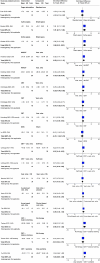Comparative effectiveness of non- pharmacological treatments in patients with persistent postural-perceptual dizziness: a systematic review and effect sizes analyses
- PMID: 39070052
- PMCID: PMC11272556
- DOI: 10.3389/fneur.2024.1426566
Comparative effectiveness of non- pharmacological treatments in patients with persistent postural-perceptual dizziness: a systematic review and effect sizes analyses
Abstract
Introduction: The patho-psychological mechanisms of persistent postural-perceptual dizziness (PPPD) appear to be very complex, and a multimodal, multidisciplinary approach is suggested for treating patients with PPPD. The aim of this review was to provide a comprehensive overview of non-pharmacological treatments and their comparative effectiveness in patients with PPPD.
Methods: Scopus, Web of Science, PsycINFO, Medline, Embase, CINAHL, Cochrane Library and ClinicalTrials.gov were searched in April 2022 with a search update in August 2023. Only randomized controlled trials (RCTs) were included. There was no restrictions regarding publication date. Two reviewers independently identified eligible trials, extracted data, double-checked all extracted information from the included articles and assessed the risk of bias using the Cochrane risk of bias tool. A qualitative synthesis was performed, considering methodological heterogeneity between trials. Finally, an effect size analysis was performed for each treatment comparison. The standardized mean differences (SMD) and their corresponding 95% confidence intervals (95%CI) were calculated for each trial using Review Manager 5.4.
Results: Thirteen RCTs (618 patients with moderate or mild dizziness) out of 1,362 references describing seven different non-pharmacological comparisons were selected. Nine trials included patients with PPPD, and four trials included patients with functional dizziness. The trials used different interventions that were classified as: (1) psychotherapeutic interventions (cognitive behavioral therapy, patient education), (2) physiotherapeutic interventions/training (vestibular rehabilitation, optokinetic stimulation), (3) stimulation procedures (vagus nerve stimulation, transcranial direct current stimulation) and (4) device application (visual desensitization using personalized glasses). However, most of the trials investigated the effects of single interventions, rather than multimodal interdisciplinary treatment of patients with PPPD. The SMD for dizziness handicap and severity was between 0.04 and 0.52 in most trials. In one trial using visual desensitization, the SMD was 1.09 (strong effect on the severity of dizziness) and 1.05 (strong effect on dizziness handicap).
Discussion: Several individual interventions have shown benefits in the treatment of patients with PPPD with small to moderate effects. However, the multimodal treatment or a combination of vestibular rehabilitation with visual desensitization, cognitive behavioral therapy including patient education, and medication support should be further investigated. Future trials should include a large sample size with severe dizziness, and provide a longer follow-up period.
Clinical trial registration: PROSPERO CRD42022320344.
Keywords: functional dizziness; non-pharmacological therapy; persistent postural-perceptual dizziness; phobic postural vertigo; visual vertigo.
Copyright © 2024 Suica, Behrendt, Ziller, Gäumann, Schädler, Hilfiker, Parmar, Gerth, Bonati and Schuster-Amft.
Conflict of interest statement
The authors declare that the research was conducted in the absence of any commercial or financial relationships that could be construed as a potential conflict of interest. The author(s) declared that they were an editorial board member of Frontiers, at the time of submission. This had no impact on the peer review process and the final decision.
Figures






References
-
- Staab JP, Eckhardt-Henn A, Horii A, Jacob R, Strupp M, Brandt T, et al. . Diagnostic criteria for persistent postural-perceptual dizziness (PPPD): consensus document of the committee for the classification of vestibular disorders of the Bárány society. J Vestib Res. (2017) 27:191–208. doi: 10.3233/VES-170622, PMID: - DOI - PMC - PubMed
Publication types
LinkOut - more resources
Full Text Sources
Miscellaneous

